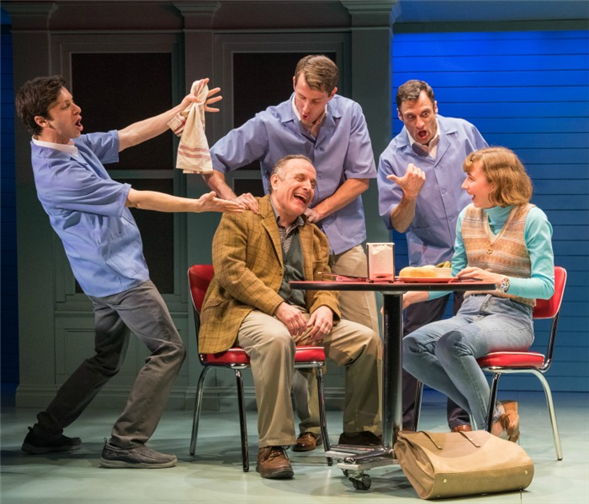Translate Page

Inside the complicated tone of A Letter to Harvey Milk
---
While the new musical A Letter to Harvey Milk explores themes of loss, regret, and denial, it leavens the heaviness with Borscht Belt-style jokes. For the creators, this mix of tragedy and humor was integral to the storytelling and the artistic process. After all, it took more than two decades to bring it to Off-Broadway.
Based on a short story of the same name by Lesléa Newman, the show is set in 1986 San Francisco. When retired kosher butcher and widower Harry (played by Broadway vet Adam Heller) takes a writing class at a Jewish community center, he strikes up an unexpected friendship with his teacher Barbara (Julia Knitel), a young lesbian dealing with a breakup and her parents' rejection. As an exercise, Barbara asks Harry to pen a thank-you note to someone who has died. But instead of writing to his late wife Frannie, he chooses his former customer Harvey Milk, California's first openly gay elected official who was assassinated in 1978. As Harry and Barbara discuss his letter, both confront crippling issues in their lives, but punch lines are used to appease their pain.
Take, for example, the number "What a Shanda," which is sung by Frannie, appearing to Harry as a vision from the beyond. She bemoans the shanda (Yiddish for disgrace) of her husband being taught by a lesbian -- not just because she's gay, but also due to her lack of feminine style. "What a shame, what a shanda! A dress, a little makeup is beyond her?"
Frannie's judgy yet jovial personality mirrors the duality of the show's tone. All of the characters have that kind of complexity. "We're not all just wonderfully likable," explains director Evan Pappas. "People have their hang-ups." Later, in another moment of unconscious homophobia, Harry is shocked by Barbara casually telling a waiter that she's a lesbian. Pappas asked the creators to expand that scene and ratchet up the discomfort. "We made it a little tougher and longer," he says. "We wanted people to recognize themselves in both sides of the argument."
Composer Laura I. Kramer initially started on A Letter to Harvey Milk back in 1995. After she secured the rights a decade later, she began working with lyricist Ellen M. Schwartz and book writer Jerry James. There were readings and a promising run at the 2012 New York Musical Theater Festival. Then Schwartz died of cancer in 2015. Kramer struggled with the loss of her friend and the stalling of their project.
But rather than abandon the show, Kramer found a way to forge ahead and keep her late collaborator's humor alive. For help with the book and lyrics, she turned to Cheryl Stern, who originated the role of Frannie at NYMF and also plays the part in the current production at the Acorn Theatre. "I knew that Cheryl was also a writer, so who better than someone who knew it from the inside?" Kramer says.
Since Frannie observes Harry and Barbara from the sidelines throughout the show, Stern had an insightful perspective. "There were times we were doing the show when I thought, we could use one verse less, or, this could be more clear," says Stern. "I never said anything. Then the opportunity came."
Together, Kramer and Stern worked to cut the story's inherent darkness with laughter. Stern cites one scene as being particularly effective at this balancing act: Right after Harry sings his letter to Harvey Milk, expressing feelings of loss and sadness, Frannie has a realization that her husband never cheated on her. Her relief breaks the somber mood: "Thank God you didn't shtup a shiksa!"
The show's score, too, is studded with contrasts. There are klezmer riffs for Harry while Barbara's melodies evoke Joni Mitchell. Harry and Barbara are generations apart, so their music and sensibilities are different. However, they bond over their shared pain and, of course, humor. As Kramer puts it: "It's a very Jewish thing to be serious and funny at the same time."
To read about a student's experience at A Letter to Harvey Milk, check out this post on TDF's sister site SEEN.
---
TDF MEMBERS: At press time, discount tickets were available for A Letter to Harvey Milk. Go here to browse our current offers.
Pia Catton is a writer and editor covering performing arts. She launched Dance.com as its editor-in-chief in 2017, and has written for The New York Times, The Wall Street Journal, Bloomberg, The New York Post, and others.
Top image: Adam Heller, Julia Knitel, Jeremy Greenbaum, CJ Pawlikowski, and Michael Bartoli in A Letter to Harvey Milk. Photos by Russ Rowland.